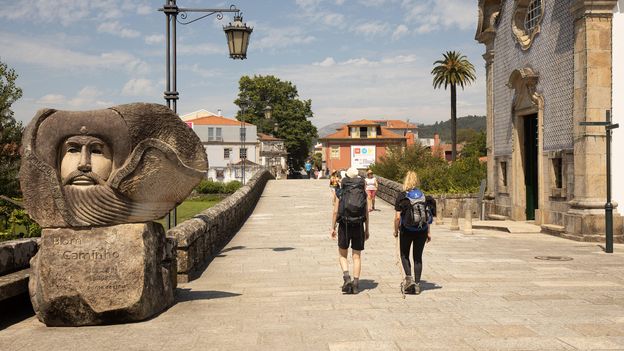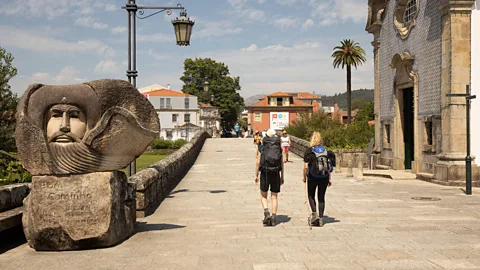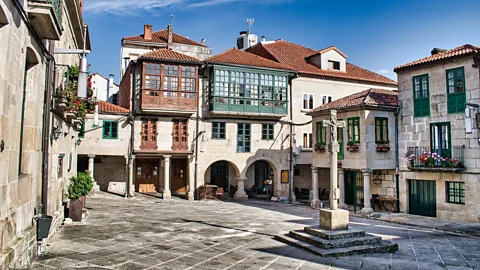Travel
The Portuguese pilgrimage you should do in 2024

 Alamy
AlamyWith 2024 expected to be the busiest year yet for the Camino de Santiago, travellers should seek out the relatively untrodden 620km Camino from Lisbon.
From the hilltop church of Lamas do Vouga, I watched two figures cross the arched Roman bridge over the wide, rushing waters of the Vouga River. Looking like strange upright tortoises with their hefty neon backpacks, they were among the tiny handful of other pilgrims I’d seen on my journey from Portugal’s capital Lisbon as I headed towards Santiago de Compostela in Spain.
Since medieval times, pilgrims have journeyed on foot to the magnificent Romanesque cathedral in Santiago where the relics of St James are housed. The network of trails from various starting points in Europe are known as Caminos – or “ways”. The French Way, which begins at Saint-Jean-Pied-de-Port near the Pyrenees, is so popular that the number of walkers is almost equal to medieval times. Back then, half a million people walked the route each year. Last year, 446,000 pilgrims registered their arrival in Santiago (the total number of walkers is likely far higher) – and 2024 is expected to be the busiest year yet. On the last 100km of the French Way, you can spot pilgrims at almost every turn, especially in the summer months when hostels and eateries are full to bursting and the queue for the cathedral can be up to three hours long.
By contrast, the Portuguese Camino, which runs 620km north from the bustling heart of Lisbon, feels relatively untrodden. Were it not for the ubiquitous scallop shell (the sign of St James) and yellow arrow waymarkers, I might have wondered if I was on the wrong path as I left Lisbon winding my way along the banks of the Tagus Estuary into bull and horse breeding country.
“The Portuguese Camino offers a very different experience,” veteran walker Colleen Sims told me. She walked her first Camino, the French Way, in 2013 and has walked another every year since, exploring a variety of routes and sometimes leading groups and writing for her blog.
 Getty Images
Getty Images“I was first drawn to the Portuguese Way by the promise of better winter weather but found it offered so much more,” she said. “It feels less iconic than the French Way, but you get to enjoy two countries, two cultures, countryside and coast, plus rural villages, major towns and cities. It has it all and is also relatively easy to walk as there are no major climbs or mountain passes.”
Like its French counterpart, this route has attracted pilgrims for centuries. The parents of Portugal’s first King, Alfonso, made their way to Santiago in 1097. Queen Isabel (later Saint Isabel) made the journey twice, in 1325 and 1335. Since then, it has been walked by countless others: the faithful and the intrepid; culture seekers and the simply curious.
It’s both a spiritual route and a trail through history. Much of the way follows Roman roads peppered with ancient milestones, and passes impressive sights like the walled Roman settlement of Conimbriga with its beautifully preserved mosaics.
Hilltop convents, walled monasteries and statues of the Virgin Mary or crosses at the centre of almost every roundabout are a reminder that in secular Europe, Portugal is still very much a Catholic country. People I met still talked excitedly about a visit to Portugal by Pope Francis last year and the open-air masses he held near the start of the Camino in Lisbon and Porto.
 Lizzie Enfield
Lizzie EnfieldHowever, 2024 is also a significant year for Portugal. On 25 April, the country celebrated the 50th anniversary of its peaceful “Carnation” Revolution that overthrew a dictatorship and paved the way for democracy. The revolution gained its moniker when, after barely a shot fired, a flower seller in Lisbon began placing carnations in the butts of the soldiers’ rifles. The image has endured: along the route I passed numerous carnations, both real and artificial, placed by the roadside, pinned to doors, strung on lampposts and scaling the side of buildings – a constant reminder of this chapter in Portuguese history.
Many who walk the Portuguese Way do so for religious and spiritual reasons, but others are on more personal journeys. At one of many azulejo (Portuguese tile)-covered churches, I met two sisters walking together. Both lost their husbands to cancer in the same year and one had also lost her child to drugs. “I’m not religious but walking this route has given me a very different perspective on life,” she told me. “There is so much history and beauty. It feels as if the place is here to remind us that we are all journeying on this Earth for a limited time but that nature and human endeavour carry on regardless.”
From Porto, famous for its eponymous fortified wine (and latterly the Livraria Lello bookstore with a staircase that inspired the moving one in Harry Potter), the route diverges. You can continue inland towards the town of Tui on the border with Spain or take the Coastal Camino along sandy boardwalks, through picturesque fishing villages and historic shipbuilding areas that flourished in Portugal’s golden Age of Discovery (1450-1750). This part of the route becomes a lot busier as pilgrims begin to mingle with regular tourists, and Santiago looms closer.
“We’ve been operating on the Camino for 15 years from all the different starting points,” says Jeremy Perrin, general manager of Camino Ways, a Dublin-based tour operator specialising in walking and cycling holidays. “While the Portuguese route is slowly drawing more visitors, most of them are on the last 100km from Vigo, while others walk 280km from Porto. However, the route between Lisbon and Porto is still relatively undiscovered. Of every 100 bookings, 60 will be on the French Way, 30 on the Portuguese Route from Vigo, and from Lisbon just one or two.”
 Getty Images
Getty ImagesFor me, this made for a quieter and more contemplative journey, passing through vineyards, past grand colonial-style houses, through eucalyptus and cork forests and fields of horses and bulls as I left the busy Lisbon suburbs and headed through the centre of Portugal to the mouth of the Douro River in Porto.
It also showed a very different side of Portugal, one far from the busy coastal resorts and popular attractions like Sintra. There, I have queued for several hours to gain admittance to its palace. In Tomar, I walked straight into the Knights Templar castle and had it mostly to myself.
The quietness of the route does have its downside. Not far from Coimbra, I met a lone pilgrim who was lost and, without a word of Portuguese, struggling to find his way back to the path. He had previously walked the French Camino and was used to following people with backpacks. In Portugal, he was finding the lack of them hard to handle. But the emptiness was offset by the hospitality of the Portuguese people, doubly delighted to see pilgrims far from the madding crowds of the usual tourist hotspots.
The last leg of the Portuguese Way crosses the Minho River and enters Spain, taking you through lush green Galicia, famous for its Albariño white wine, through the old Gothic quarter of imposing Pontevedra and to the oyster-fishing port of Arcade. The last stop before Santiago is Padrón, home of the eponymous peppers and Galician poet Rosalía de Castro. As I hiked this stretch, the number of walkers visibly increased, but it was still less populated than the busy last part of the French Way.
The popular Spanish name for the Milky Way is El Camino de Santiago. According to medieval legend, the hazy mass of stars, too numerous to be individually distinguished was formed from the dust raised by travelling pilgrims. The less-travelled Portuguese way is more like a constellation, its sites and shrines brighter and clearer for not being eclipsed by the hordes.
CORRECTION: A previous version of this story incorrectly spelled the Minho River. It has been corrected.
Slowcomotion is a BBC Travel series that celebrates slow, self-propelled travel and invites readers to get outside and reconnect with the world in a safe and sustainable way.











